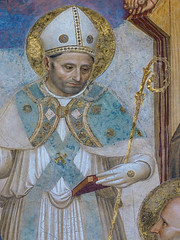Augustine's mission to England 597
Primary tabs
In late 6th-century England, Christianity had largely disappeared after the Anglo-Saxon invasions. The Anglo-Saxons were pagan, though some Christian communities survived in Celtic Britain (especially in the north and west).12
 Pope Gregory I wanted to bring the Anglo-Saxons into the Church, both to save souls and to extend Roman Christianity’s influence. Augustine who was prior of Gregory’s own monastery of St. Andrew in Rome, and 40 monks, was in 596 to Britain. They traveled through Gaul, and Augustine initially lost heart and tried to return to Rome, but Gregory urged him to continue. Augustine landed in Kent sometime in 597 (the exact day and month is unknown). Having arrived he sent messengers to King Æthelberht, announcing they had come from Rome with good news about eternal life.
Pope Gregory I wanted to bring the Anglo-Saxons into the Church, both to save souls and to extend Roman Christianity’s influence. Augustine who was prior of Gregory’s own monastery of St. Andrew in Rome, and 40 monks, was in 596 to Britain. They traveled through Gaul, and Augustine initially lost heart and tried to return to Rome, but Gregory urged him to continue. Augustine landed in Kent sometime in 597 (the exact day and month is unknown). Having arrived he sent messengers to King Æthelberht, announcing they had come from Rome with good news about eternal life.
Æthelberht was initially cautious, and he ordered them to remain on the island until he decided how to respond. King Æthelberht was married to Bertha, a Frankish Christian princess. Bertha’s faith and the presence of her chaplain (Bishop Liudhard) softened the king’s attitude towards Augustine and his monks. According to Bede, when Æthelberht finally agreed to meet them, the king insisted that the meeting take place outdoors, fearing that their “spells” (i.e., prayers) might harm him if spoken under a roof.
Augustine and his monks approached in procession, carrying a silver cross and an image of Christ on a painted board. They chanted litanies, praying for the salvation of the people of Kent. Augustine preached to Æthelberht about the Christian faith and eternal life. Although he did not immediately convert, soon after, Ethelbert himself was baptized, which was a huge success for the mission, and paved the way for the wider conversion of the Anglo-Saxons in Kent.
Æthelberht allowed Augustine and his companions to settle in Canterbury, his royal city, and gave them the use of an old church (St. Martin’s, already in use by Queen Bertha for worship). Where they began preaching, living simply, and many locals converted.
When Augustine’s missionaries asked Pope Gregory how to handle pagan shrines and practices in England, Gregory encouraged gradual adaptation, and gave a practical and pastoral answer (recorded by Bede, Ecclesiastical History, Book I, Chapter 30):3
Tell Augustine that he should not destroy the temples of the idols among that people, but let the idols that are in them be destroyed; let holy water be made and sprinkled in the temples, let altars be set up, and relics placed there. For if the temples are well built, they should be converted from the worship of demons to the service of the true God. In this way the people, seeing that their temples are not destroyed, will more readily come to the places they are used to and, familiar with the place, will worship the true God there.
And because they are accustomed to slaughter many oxen in sacrifice to demons, some solemnity ought to be given them in exchange for this. For this reason, on the day of the dedication, or on the festivals of the holy martyrs whose relics are placed there, let them build huts of branches around those same temples once converted, and celebrate the solemnity with religious feasting. They should no longer sacrifice animals to the devil, but kill them for their own food to the glory of God, and give thanks to the Giver of all things. Thus, if they are permitted outward pleasures, they will more easily consent to the inward joys. For it is impossible to cut away everything at once from rough hearts, since he who strives to climb to the highest place rises gradually, step by step, not by leaps.
Gregory’s approach in England was pragmatic and pastoral, designed for a population unfamiliar with Christianity and a ruler who might reject it. In France, the Church could lean on royal authority, so destruction was feasible and politically useful.
- 1.
The English Conquest: Gildas And Britain In The Fifth Century Manchester Manchester University Press 1994..
- 2.
The English Settlements Oxford History Of England Oxford History Of England Oxford Clarendon Press 1986..
- 3. Ecclesiastical History, Book I https://sourcebooks.fordham.edu/basis/bede-book1.asp
